spare tire MAZDA MODEL 6 2014 Owners Manual (in English)
[x] Cancel search | Manufacturer: MAZDA, Model Year: 2014, Model line: MODEL 6, Model: MAZDA MODEL 6 2014Pages: 576, PDF Size: 8.58 MB
Page 120 of 576
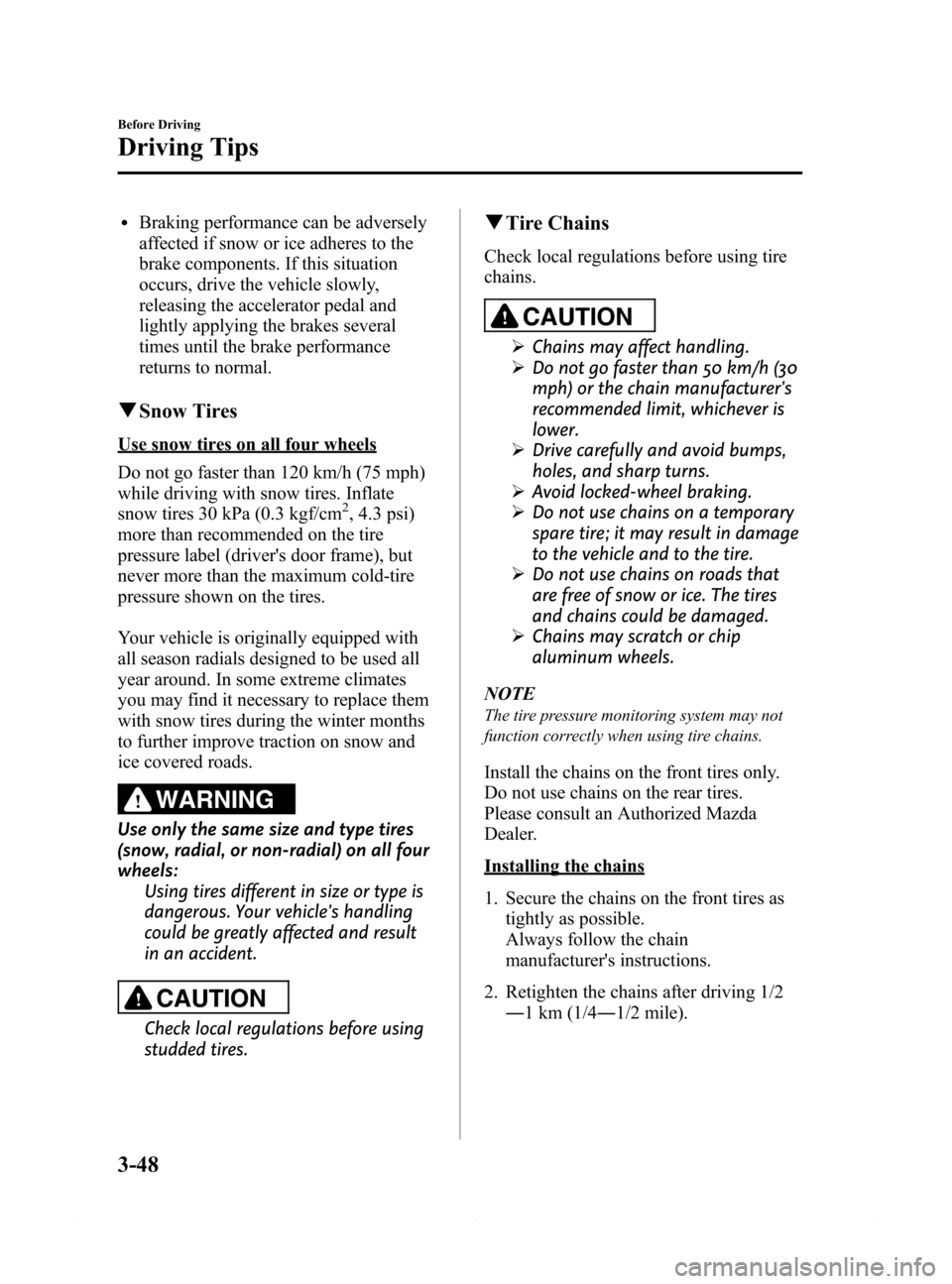
Black plate (120,1)
lBraking performance can be adversely
affected if snow or ice adheres to the
brake components. If this situation
occurs, drive the vehicle slowly,
releasing the accelerator pedal and
lightly applying the brakes several
times until the brake performance
returns to normal.
qSnow Tires
Use snow tires on all four wheels
Do not go faster than 120 km/h (75 mph)
while driving with snow tires. Inflate
snow tires 30 kPa (0.3 kgf/cm
2, 4.3 psi)
more than recommended on the tire
pressure label (driver's door frame), but
never more than the maximum cold-tire
pressure shown on the tires.
Your vehicle is originally equipped with
all season radials designed to be used all
year around. In some extreme climates
you may find it necessary to replace them
with snow tires during the winter months
to further improve traction on snow and
ice covered roads.
WARNING
Use only the same size and type tires
(snow, radial, or non-radial) on all four
wheels:
Using tires different in size or type is
dangerous. Your vehicle's handling
could be greatly affected and result
in an accident.
CAUTION
Check local regulations before using
studded tires.
qTire Chains
Check local regulations before using tire
chains.
CAUTION
ØChains may affect handling.
ØDo not go faster than 50 km/h (30
mph) or the chain manufacturer's
recommended limit, whichever is
lower.
ØDrive carefully and avoid bumps,
holes, and sharp turns.
ØAvoid locked-wheel braking.
ØDo not use chains on a temporary
spare tire; it may result in damage
to the vehicle and to the tire.
ØDo not use chains on roads that
are free of snow or ice. The tires
and chains could be damaged.
ØChains may scratch or chip
aluminum wheels.
NOTE
The tire pressure monitoring system may not
function correctly when using tire chains.
Install the chains on the front tires only.
Do not use chains on the rear tires.
Please consult an Authorized Mazda
Dealer.
Installing the chains
1. Secure the chains on the front tires as
tightly as possible.
Always follow the chain
manufacturer's instructions.
2. Retighten the chains after driving 1/2
―1 km (1/4―1/2 mile).
3-48
Before Driving
Driving Tips
Mazda6_8DQ8-EA-13L_Edition3 Page120
Friday, June 13 2014 6:21 PM
Form No.8DQ8-EA-13L
Page 158 of 576
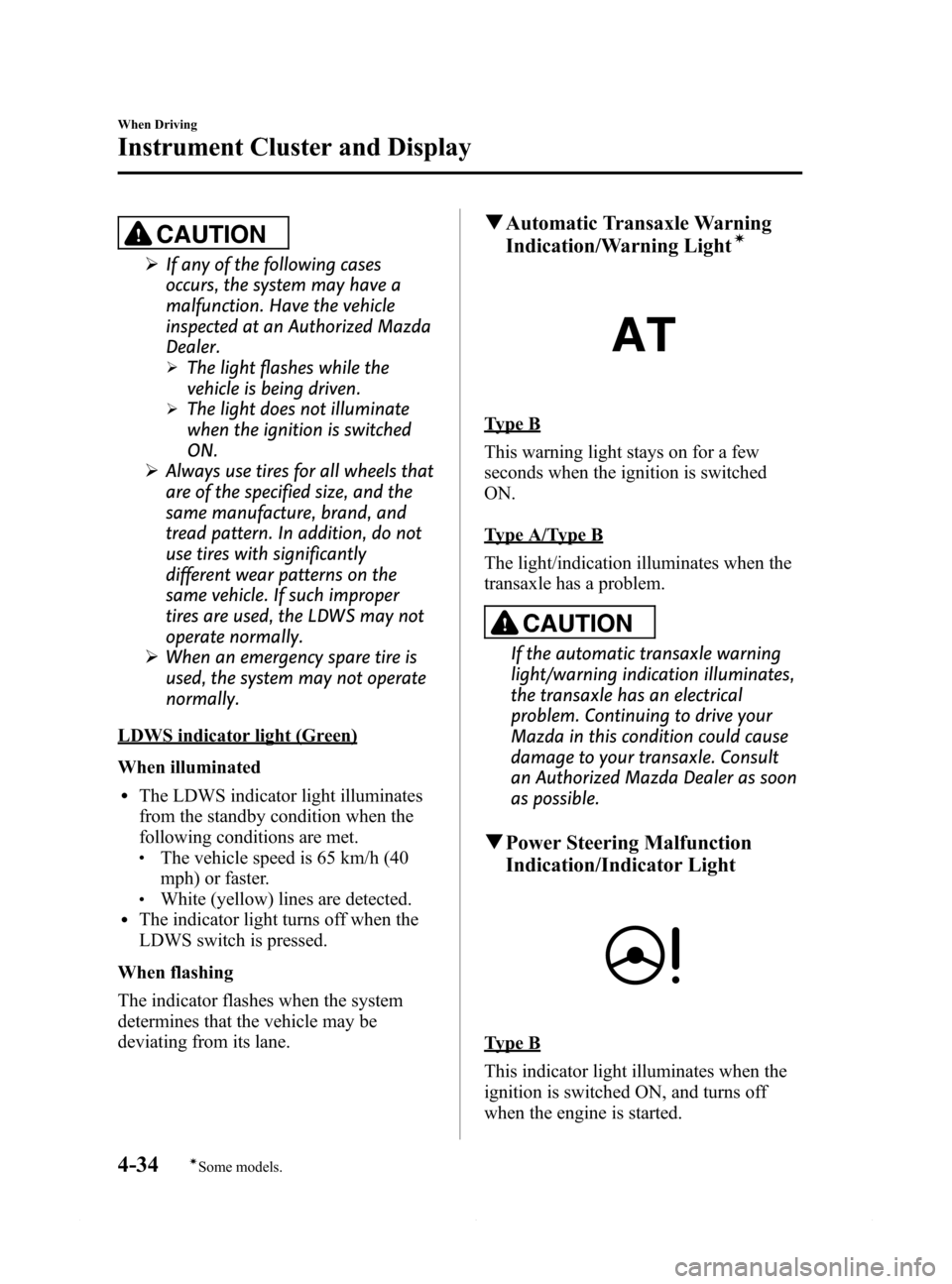
Black plate (158,1)
CAUTION
ØIf any of the following cases
occurs, the system may have a
malfunction. Have the vehicle
inspected at an Authorized Mazda
Dealer.
ØThe light flashes while the
vehicle is being driven.
ØThe light does not illuminate
when the ignition is switched
ON.
ØAlways use tires for all wheels that
are of the specified size, and the
same manufacture, brand, and
tread pattern. In addition, do not
use tires with significantly
different wear patterns on the
same vehicle. If such improper
tires are used, the LDWS may not
operate normally.
ØWhen an emergency spare tire is
used, the system may not operate
normally.
LDWS indicator light (Green)
When illuminated
lThe LDWS indicator light illuminates
from the standby condition when the
following conditions are met.
lThe vehicle speed is 65 km/h (40
mph) or faster.
lWhite (yellow) lines are detected.lThe indicator light turns off when the
LDWS switch is pressed.
When flashing
The indicator flashes when the system
determines that the vehicle may be
deviating from its lane.
qAutomatic Transaxle Warning
Indication/Warning Lightí
Type B
This warning light stays on for a few
seconds when the ignition is switched
ON.
Type A/Type B
The light/indication illuminates when the
transaxle has a problem.
CAUTION
If the automatic transaxle warning
light/warning indication illuminates,
the transaxle has an electrical
problem. Continuing to drive your
Mazda in this condition could cause
damage to your transaxle. Consult
an Authorized Mazda Dealer as soon
as possible.
qPower Steering Malfunction
Indication/Indicator Light
Type B
This indicator light illuminates when the
ignition is switched ON, and turns off
when the engine is started.
4-34
When Driving
íSome models.
Instrument Cluster and Display
Mazda6_8DQ8-EA-13L_Edition3 Page158
Friday, June 13 2014 6:21 PM
Form No.8DQ8-EA-13L
Page 163 of 576
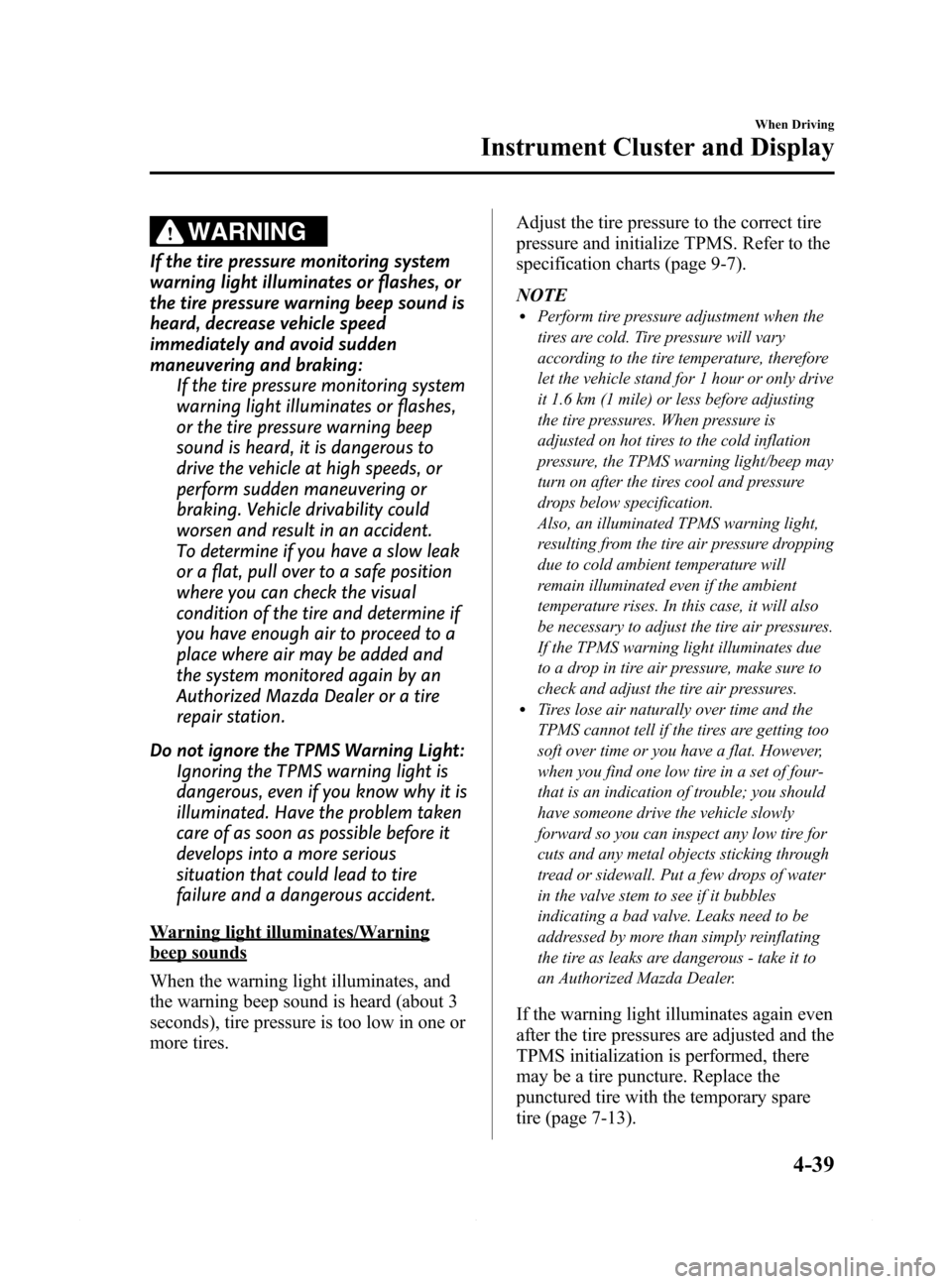
Black plate (163,1)
WARNING
If the tire pressure monitoring system
warning light illuminates or flashes, or
the tire pressure warning beep sound is
heard, decrease vehicle speed
immediately and avoid sudden
maneuvering and braking:
If the tire pressure monitoring system
warning light illuminates or flashes,
or the tire pressure warning beep
sound is heard, it is dangerous to
drive the vehicle at high speeds, or
perform sudden maneuvering or
braking. Vehicle drivability could
worsen and result in an accident.
To determine if you have a slow leak
or a flat, pull over to a safe position
where you can check the visual
condition of the tire and determine if
you have enough air to proceed to a
place where air may be added and
the system monitored again by an
Authorized Mazda Dealer or a tire
repair station.
Do not ignore the TPMS Warning Light:
Ignoring the TPMS warning light is
dangerous, even if you know why it is
illuminated. Have the problem taken
care of as soon as possible before it
develops into a more serious
situation that could lead to tire
failure and a dangerous accident.
Warning light illuminates/Warning
beep sounds
When the warning light illuminates, and
the warning beep sound is heard (about 3
seconds), tire pressure is too low in one or
more tires.Adjust the tire pressure to the correct tire
pressure and initialize TPMS. Refer to the
specification charts (page 9-7).
NOTE
lPerform tire pressure adjustment when the
tires are cold. Tire pressure will vary
according to the tire temperature, therefore
let the vehicle stand for 1 hour or only drive
it 1.6 km (1 mile) or less before adjusting
the tire pressures. When pressure is
adjusted on hot tires to the cold inflation
pressure, the TPMS warning light/beep may
turn on after the tires cool and pressure
drops below specification.
Also, an illuminated TPMS warning light,
resulting from the tire air pressure dropping
due to cold ambient temperature will
remain illuminated even if the ambient
temperature rises. In this case, it will also
be necessary to adjust the tire air pressures.
If the TPMS warning light illuminates due
to a drop in tire air pressure, make sure to
check and adjust the tire air pressures.
lTires lose air naturally over time and the
TPMS cannot tell if the tires are getting too
soft over time or you have a flat. However,
when you find one low tire in a set of four-
that is an indication of trouble; you should
have someone drive the vehicle slowly
forward so you can inspect any low tire for
cuts and any metal objects sticking through
tread or sidewall. Put a few drops of water
in the valve stem to see if it bubbles
indicating a bad valve. Leaks need to be
addressed by more than simply reinflating
the tire as leaks are dangerous - take it to
an Authorized Mazda Dealer.
If the warning light illuminates again even
after the tire pressures are adjusted and the
TPMS initialization is performed, there
may be a tire puncture. Replace the
punctured tire with the temporary spare
tire (page 7-13).
When Driving
Instrument Cluster and Display
4-39
Mazda6_8DQ8-EA-13L_Edition3 Page163
Friday, June 13 2014 6:21 PM
Form No.8DQ8-EA-13L
Page 188 of 576
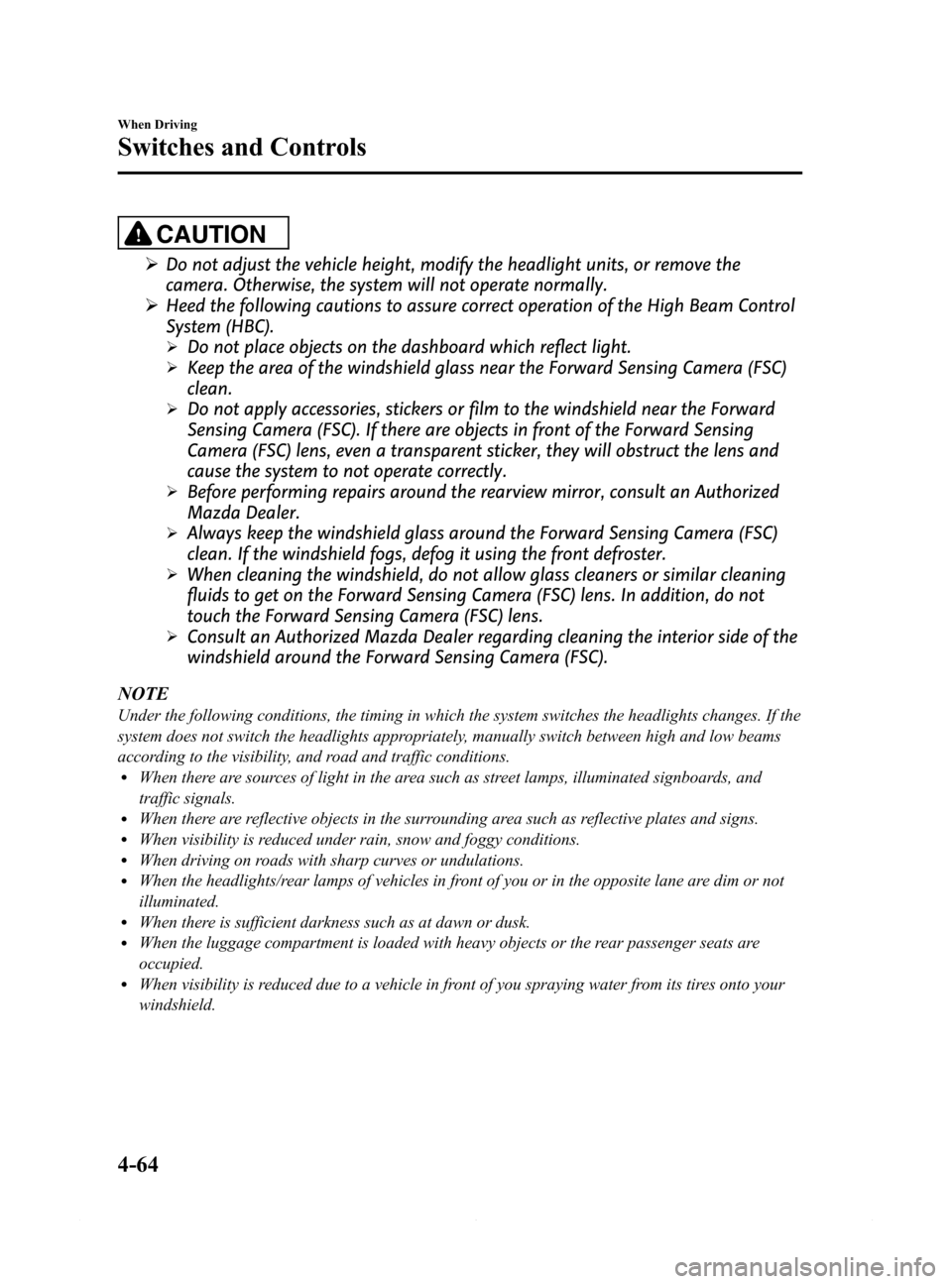
Black plate (188,1)
CAUTION
ØDo not adjust the vehicle height, modify the headlight units, or remove the
camera. Otherwise, the system will not operate normally.
ØHeed the following cautions to assure correct operation of the High Beam Control
System (HBC).
ØDo not place objects on the dashboard which reflect light.
ØKeep the area of the windshield glass near the Forward Sensing Camera (FSC)
clean.
ØDo not apply accessories, stickers or film to the windshield near the Forward
Sensing Camera (FSC). If there are objects in front of the Forward Sensing
Camera (FSC) lens, even a transparent sticker, they will obstruct the lens and
cause the system to not operate correctly.
ØBefore performing repairs around the rearview mirror, consult an Authorized
Mazda Dealer.
ØAlways keep the windshield glass around the Forward Sensing Camera (FSC)
clean. If the windshield fogs, defog it using the front defroster.
ØWhen cleaning the windshield, do not allow glass cleaners or similar cleaning
fluids to get on the Forward Sensing Camera (FSC) lens. In addition, do not
touch the Forward Sensing Camera (FSC) lens.
ØConsult an Authorized Mazda Dealer regarding cleaning the interior side of the
windshield around the Forward Sensing Camera (FSC).
NOTE
Under the following conditions, the timing in which the system switches the headlights changes. If the
system does not switch the headlights appropriately, manually switch between high and low beams
according to the visibility, and road and traffic conditions.
lWhen there are sources of light in the area such as street lamps, illuminated signboards, and
traffic signals.
lWhen there are reflective objects in the surrounding area such as reflective plates and signs.lWhen visibility is reduced under rain, snow and foggy conditions.lWhen driving on roads with sharp curves or undulations.lWhen the headlights/rear lamps of vehicles in front of you or in the opposite lane are dim or not
illuminated.
lWhen there is sufficient darkness such as at dawn or dusk.lWhen the luggage compartment is loaded with heavy objects or the rear passenger seats are
occupied.
lWhen visibility is reduced due to a vehicle in front of you spraying water from its tires onto your
windshield.
4-64
When Driving
Switches and Controls
Mazda6_8DQ8-EA-13L_Edition3 Page188
Friday, June 13 2014 6:21 PM
Form No.8DQ8-EA-13L
Page 204 of 576
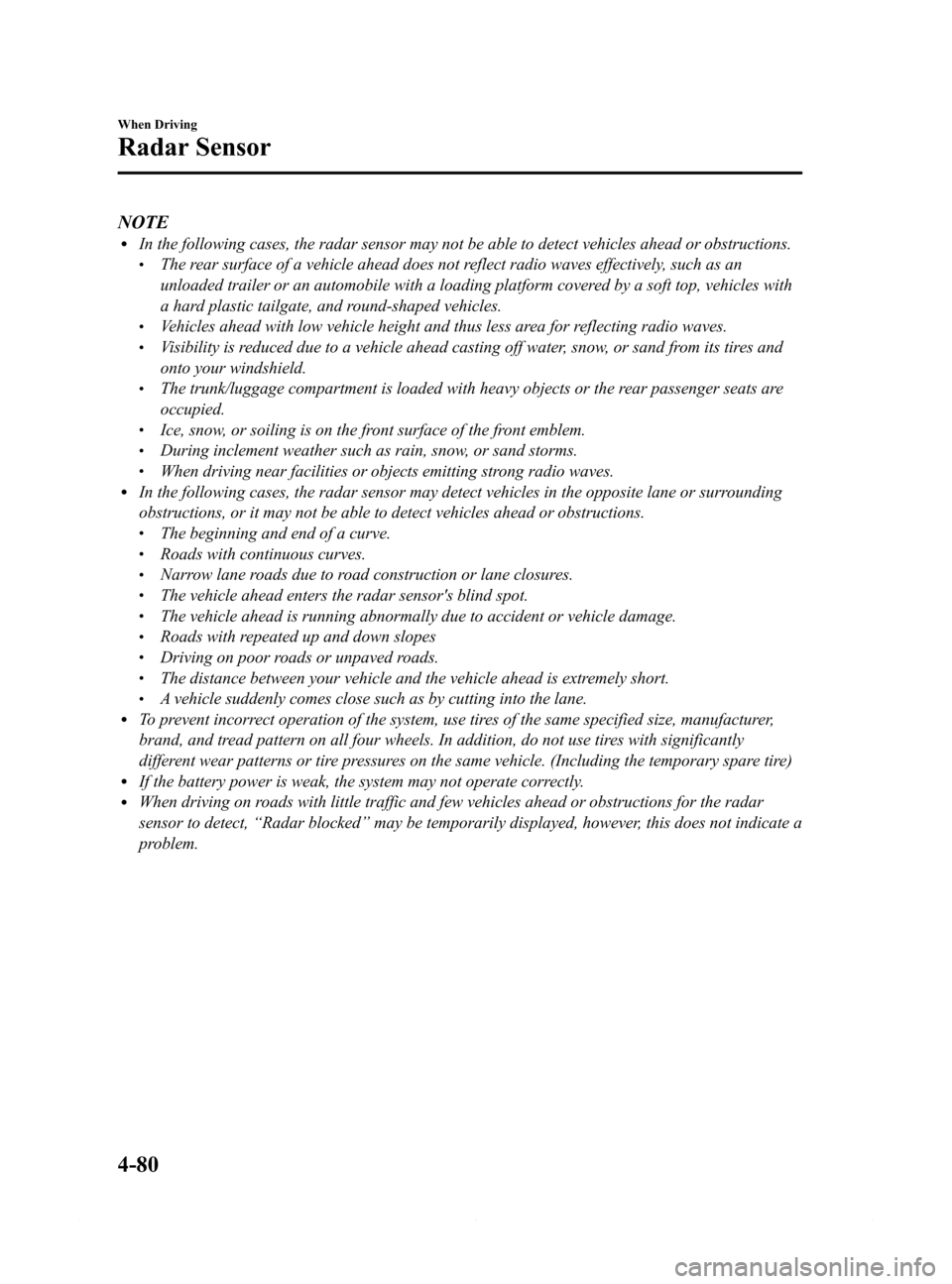
Black plate (204,1)
NOTElIn the following cases, the radar sensor may not be able to detect vehicles ahead or obstructions.lThe rear surface of a vehicle ahead does not reflect radio waves effectively, such as an
unloaded trailer or an automobile with a loading platform covered by a soft top, vehicles with
a hard plastic tailgate, and round-shaped vehicles.
lVehicles ahead with low vehicle height and thus less area for reflecting radio waves.lVisibility is reduced due to a vehicle ahead casting off water, snow, or sand from its tires and
onto your windshield.
lThe trunk/luggage compartment is loaded with heavy objects or the rear passenger seats are
occupied.
lIce, snow, or soiling is on the front surface of the front emblem.lDuring inclement weather such as rain, snow, or sand storms.lWhen driving near facilities or objects emitting strong radio waves.lIn the following cases, the radar sensor may detect vehicles in the opposite lane or surrounding
obstructions, or it may not be able to detect vehicles ahead or obstructions.
lThe beginning and end of a curve.lRoads with continuous curves.lNarrow lane roads due to road construction or lane closures.lThe vehicle ahead enters the radar sensor's blind spot.lThe vehicle ahead is running abnormally due to accident or vehicle damage.lRoads with repeated up and down slopeslDriving on poor roads or unpaved roads.lThe distance between your vehicle and the vehicle ahead is extremely short.lA vehicle suddenly comes close such as by cutting into the lane.lTo prevent incorrect operation of the system, use tires of the same specified size, manufacturer,
brand, and tread pattern on all four wheels. In addition, do not use tires with significantly
different wear patterns or tire pressures on the same vehicle. (Including the temporary spare tire)
lIf the battery power is weak, the system may not operate correctly.lWhen driving on roads with little traffic and few vehicles ahead or obstructions for the radar
sensor to detect,“Radar blocked”may be temporarily displayed, however, this does not indicate a
problem.
4-80
When Driving
Radar Sensor
Mazda6_8DQ8-EA-13L_Edition3 Page204
Friday, June 13 2014 6:21 PM
Form No.8DQ8-EA-13L
Page 218 of 576

Black plate (218,1)
Dynamic Stability Control
(DSC)
The Dynamic Stability Control (DSC)
automatically controls braking and engine
torque in conjunction with systems such
as ABS and TCS to help control side slip
when driving on slippery surfaces, or
during sudden or evasive maneuvering,
enhancing vehicle safety.
Refer to ABS (page 4-92) and TCS (page
4-93).
DSC operation is possible at speeds
greater than 20 km/h (12 mph).
A system malfunction or operation
conditions are indicated by a warning.
Refer to Warning/Indicator Lights on page
4-23.
WARNING
Do not rely on the Dynamic Stability
Control as a substitute for safe driving:
The Dynamic Stability Control (DSC)
cannot compensate for unsafe and
reckless driving, excessive speed,
tailgating (following another vehicle
too closely), and hydroplaning
(reduced tire friction and road
contact because of water on the road
surface). You can still have an
accident.
CAUTION
ØThe DSC may not operate correctly
unless the following are observed:
ØUse tires of the correct size
specified for your Mazda on all
four wheels.
ØUse tires of the same
manufacturer, brand and tread
pattern on all four wheels.
ØDo not mix worn tires.
ØThe DSC may not operate correctly
when tire chains are used or a
temporary spare tire is installed
because the tire diameter changes.
qDSC OFF Switch
Press the DSC OFF switch to turn off the
TCS/DSC. The DSC OFF indicator light
in the instrument cluster will illuminate.
Press the switch again to turn the TCS/
DSC back on. The DSC OFF indicator
light will turn off.
4-94
When Driving
ABS/TCS/DSC
Mazda6_8DQ8-EA-13L_Edition3 Page218
Friday, June 13 2014 6:21 PM
Form No.8DQ8-EA-13L
Page 242 of 576

Black plate (242,1)
CAUTION
Each tire, including the spare (if provided), should be checked monthly when cold
and inflated to the inflation pressure recommended by the vehicle manufacturer on
the vehicle placard or tire inflation pressure label. (If your vehicle has tires of a
different size than the size indicated on the vehicle placard or tire inflation pressure
label, you should determine the proper tire inflation pressure for those tires.)
As an added safety feature, your vehicle has been equipped with a tire pressure
monitoring system (TPMS) that illuminates a low tire pressure telltale when one or
more of your tires is significantly under-inflated. Accordingly, when the low tire
pressure telltale illuminates, you should stop and check your tires as soon as
possible, and inflate them to the proper pressure. Driving on a significantly under-
inflated tire causes the tire to overheat and can lead to tire failure. Under-inflation
also reduces fuel efficiency and tire tread life, and may affect the vehicle's handling
and stopping ability.
Please note that the TPMS is not a substitute for proper tire maintenance, and it is
the driver's responsibility to maintain correct tire pressure, even if under-inflation
has not reached the level to trigger illumination of the TPMS low tire pressure
telltale.
Your vehicle has also been equipped with a TPMS malfunction indicator to indicate
when the system is not operating properly.
The TPMS malfunction indicator is combined with the low tire pressure telltale.
When the system detects a malfunction, the telltale will flash for approximately one
minute and then remain continuously illuminated. This sequence will continue upon
subsequent vehicle start-ups as long as the malfunction exists. When the
malfunction indicator is illuminated, the system may not be able to detect or signal
low tire pressure as intended. TPMS malfunctions may occur for a variety of reasons,
including the installation of replacement or alternate tires or wheels on the vehicle
that prevent the TPMS from functioning properly. Always check the TPMS
malfunction telltale after replacing one or more tires or wheels on your vehicle to
ensure that the replacement or alternate tires and wheels allow the TPMS to
continue to function properly.
To avoid false readings, the system samples for a little while before indicating a
problem. As a result it will not instantaneously register a rapid tire deflation or blow
out.
4-118
When Driving
Tire Pressure Monitoring System
Mazda6_8DQ8-EA-13L_Edition3 Page242
Friday, June 13 2014 6:21 PM
Form No.8DQ8-EA-13L
Page 261 of 576

Black plate (261,1)
Rear View Monitorí
The rear view monitor provides visual images of the rear of the vehicle when reversing.
WARNING
Always drive carefully confirming the safety of the rear and the surrounding
conditions by looking directly with your eyes:
Reversing the vehicle by only looking at the screen is dangerous as it may cause an
accident or a collision with an object. The rear view monitor is only a visual assist
device when reversing the vehicle. The images on the screen may be different from
the actual conditions.
CAUTION
ØDo not use the rear view monitor under the following conditions: Using the rear
view monitor under the following conditions is dangerous and could result in
injury or vehicle damage or both.
ØIcy or snow-covered roads.
ØTire chains or a temporary spare tire is installed.
ØThe trunk lid is not fully closed.
ØThe vehicle is on a road incline.
ØWhen the display is cold, images may course across the monitor or the screen and
may be dimmer than usual, which could cause difficulty in confirming the
surrounding conditions of the vehicle. Always drive carefully confirming the safety
of the rear and the surrounding conditions by looking directly with your eyes.
ØDo not apply excessive force to the camera. The camera position and angle may
deviate.
ØDo not disassemble, modify, or remove it as it may no longer be waterproof.
ØThe camera cover is made of plastic. Do not apply degreasing agents, organic
solvents, wax, or glass coating agents to the camera cover. If any are spilled on
the cover, wipe off with a soft cloth immediately.
ØDo not rub the cover excessively, or polish it using an abrasive compound or a
hard brush. The cover may be damaged affecting the image.
NOTE
lIf water, snow, or mud is stuck on the camera lens, wipe it off using a soft cloth. If it cannot be
wiped off, use a mild detergent.
lIf the camera temperature changes rapidly (Hot to cold, cold to hot), the rear view monitor may
not operate correctly.
lWhen replacing the tires, consult an Authorized Mazda Dealer. Replacing the tires could result in
deviation of the guide lines which appear on the display.
lIf the vehicle's front, side, or rear has been involved in a collision, the alignment of the rear view
parking camera (location, installation angle) may have deviated. Always consult an Authorized
Mazda Dealer to have the vehicle inspected.
When Driving
Rear View Monitor
4-137íSome models. Mazda6_8DQ8-EA-13L_Edition3 Page261
Friday, June 13 2014 6:21 PM
Form No.8DQ8-EA-13L
Page 428 of 576

Black plate (428,1)
CAUTION
ØBe careful not to allow the rubber
ring shown in the figure to be
scratched or damaged.
ØIf the rubber ring detaches,
reattach it before inserting a new
battery.
Rubber ring
Tires
For reasons of proper performance, safety,
and better fuel economy, always maintain
recommended tire inflation pressures and
stay within the recommended load limits
and weight distribution.
WARNING
Using Different Tire Types:
Driving your vehicle with different
types of tires is dangerous. It could
cause poor handling and poor
braking; leading to loss of control.
Except for the limited use of the
temporary spare tire, use only the
same type tires (radial, bias-belted,
bias-type) on all four wheels.
Using Wrong-Sized Tires:
Using any other tire size than what is
specified for your Mazda (page 9-7) is
dangerous. It could seriously affect
ride, handling, ground clearance, tire
clearance, and speedometer
calibration. This could cause you to
have an accident. Use only tires that
are the correct size specified for your
Mazda.
6-34
Maintenance and Care
Owner Maintenance
Mazda6_8DQ8-EA-13L_Edition3 Page428
Friday, June 13 2014 6:23 PM
Form No.8DQ8-EA-13L
Page 429 of 576
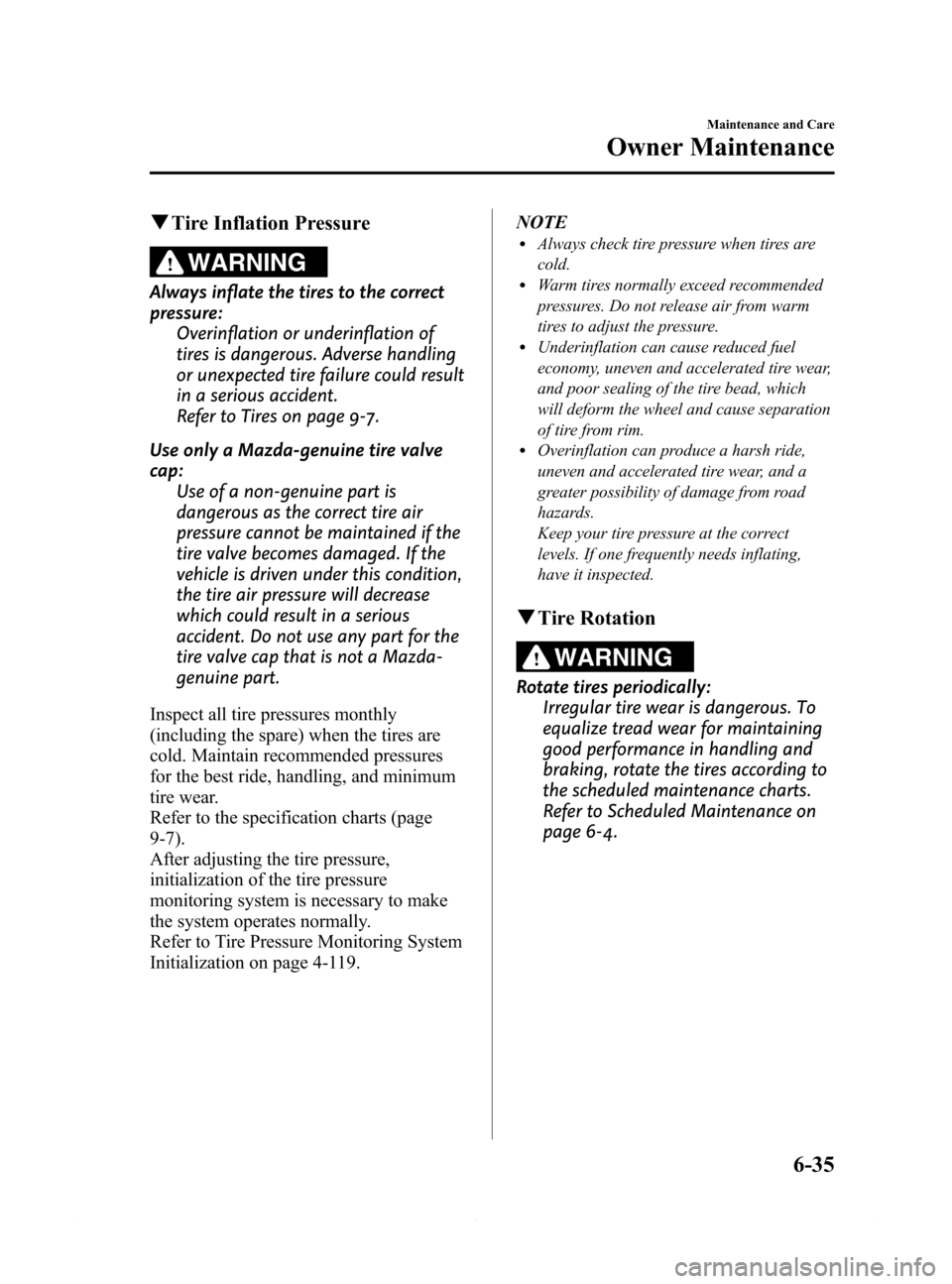
Black plate (429,1)
qTire Inflation Pressure
WARNING
Always inflate the tires to the correct
pressure:
Overinflation or underinflation of
tires is dangerous. Adverse handling
or unexpected tire failure could result
in a serious accident.
Refer to Tires on page 9-7.
Use only a Mazda-genuine tire valve
cap:
Use of a non-genuine part is
dangerous as the correct tire air
pressure cannot be maintained if the
tire valve becomes damaged. If the
vehicle is driven under this condition,
the tire air pressure will decrease
which could result in a serious
accident. Do not use any part for the
tire valve cap that is not a Mazda-
genuine part.
Inspect all tire pressures monthly
(including the spare) when the tires are
cold. Maintain recommended pressures
for the best ride, handling, and minimum
tire wear.
Refer to the specification charts (page
9-7).
After adjusting the tire pressure,
initialization of the tire pressure
monitoring system is necessary to make
the system operates normally.
Refer to Tire Pressure Monitoring System
Initialization on page 4-119.NOTE
lAlways check tire pressure when tires are
cold.
lWarm tires normally exceed recommended
pressures. Do not release air from warm
tires to adjust the pressure.
lUnderinflation can cause reduced fuel
economy, uneven and accelerated tire wear,
and poor sealing of the tire bead, which
will deform the wheel and cause separation
of tire from rim.
lOverinflation can produce a harsh ride,
uneven and accelerated tire wear, and a
greater possibility of damage from road
hazards.
Keep your tire pressure at the correct
levels. If one frequently needs inflating,
have it inspected.
qTire Rotation
WARNING
Rotate tires periodically:
Irregular tire wear is dangerous. To
equalize tread wear for maintaining
good performance in handling and
braking, rotate the tires according to
the scheduled maintenance charts.
Refer to Scheduled Maintenance on
page 6-4.
Maintenance and Care
Owner Maintenance
6-35
Mazda6_8DQ8-EA-13L_Edition3 Page429
Friday, June 13 2014 6:23 PM
Form No.8DQ8-EA-13L